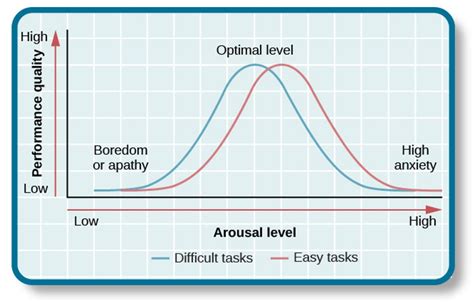The Yerkes-Dodson law, formulated by psychologists Robert Yerkes and John Dodson in 1908, postulates a fascinating relationship between an individual’s arousal level and their performance on cognitive tasks. It suggests that an optimal level of arousal facilitates peak performance, while both under-arousal and over-arousal can lead to diminished outcomes.

Understanding Arousal
Arousal, a psychological construct, refers to the level of activation or excitement an individual experiences. It can range from low levels, such as when relaxed or bored, to high levels, such as when anxious or stressed. Arousal is influenced by various factors, including environmental stimuli, internal thoughts, and physiological changes.
The Yerkes-Dodson Curve
The Yerkes-Dodson law is often depicted graphically as an inverted U-shaped curve. This curve illustrates that:
- Low Arousal: When arousal is too low, individuals may struggle to focus, lack motivation, and perform poorly on tasks.
- Optimal Arousal: There is an optimal level of arousal at which individuals perform best. This level varies depending on the task and individual differences.
- High Arousal: As arousal increases beyond the optimal level, performance begins to decline. This is because excessive arousal can impair attention, memory, and decision-making abilities.
Implications for Psychology
The Yerkes-Dodson law has significant implications for understanding human behavior and performance:
- Cognitive Tasks: Optimal arousal facilitates better performance on tasks involving attention, memory, and reasoning.
- Motivation: Moderate arousal can enhance motivation and drive individuals to perform better.
- Stress and Anxiety: Excessive arousal can lead to stress and anxiety, which can hinder performance and impair decision-making.
- Individual Differences: The optimal level of arousal can vary significantly between individuals, depending on personality traits, experience, and task difficulty.
Applications in Diverse Fields
The Yerkes-Dodson law has found practical applications in a wide range of fields, including:
- Education: Teachers can apply the Yerkes-Dodson law to create classroom environments that foster optimal arousal levels for student learning.
- Sports: Athletes use techniques to manage their arousal levels, such as relaxation exercises before competition or using energy drinks during training.
- Medicine: Healthcare professionals consider the Yerkes-Dodson law when prescribing medications or treatments that can affect arousal levels.
Tips for Finding Your Optimal Arousal Level
- Identify Activities That Arouse You: Engage in activities that consistently produce a moderate level of arousal, such as exercise or creative pursuits.
- Identify Your Triggers: Pay attention to situations or events that trigger high or low arousal and develop strategies to manage them effectively.
- Practice Relaxation Techniques: Learn and practice techniques like deep breathing, meditation, or yoga to reduce stress and lower arousal levels.
- Seek Professional Help: If you experience persistent difficulties with arousal levels that significantly impact your life, consider seeking professional guidance.
Useful Tables
| Arousal Level | Performance | Examples |
|---|---|---|
| Low | Poor | Lack of focus, difficulty in decision making |
| Moderate | Optimal | Improved concentration, memory, creativity |
| High | Poor | Anxiety, impaired attention, reduced problem-solving ability |
| Task | Optimal Arousal Level |
|---|---|
| Mathematical problem-solving | Moderate |
| Sports competition | High |
| Reading a relaxing book | Low |
| Triggers of High Arousal | Triggers of Low Arousal |
|---|---|
| Stressful situations | Boredom |
| Caffeine consumption | Lack of sleep |
| Public speaking | Prolonged inactivity |
| Strategies for Managing Arousal |
|—|—|
| Relaxation exercises (e.g., deep breathing) | Exercise |
| Mindfulness meditation | Social interaction |
| Positive self-talk | Setting realistic goals |
Conclusion
The Yerkes-Dodson law provides valuable insights into the intricate relationship between arousal and performance. By understanding the optimal level of arousal for different tasks and situations, individuals can maximize their cognitive abilities, enhance their performance, and achieve greater success.
